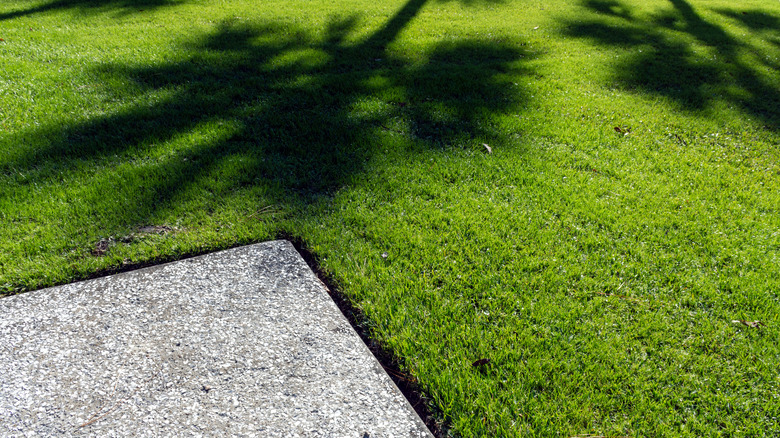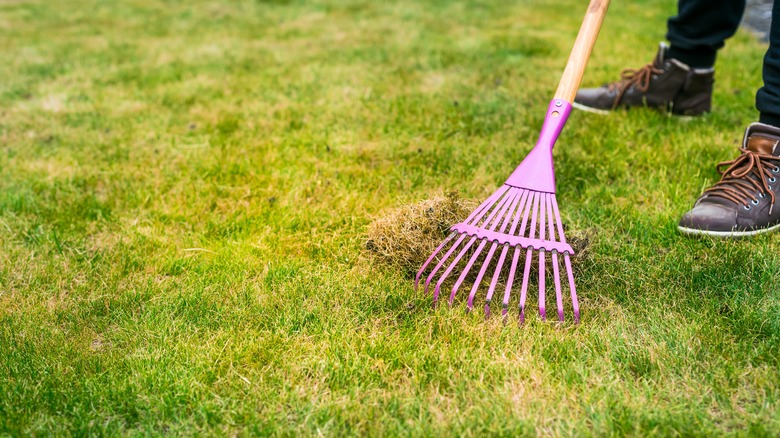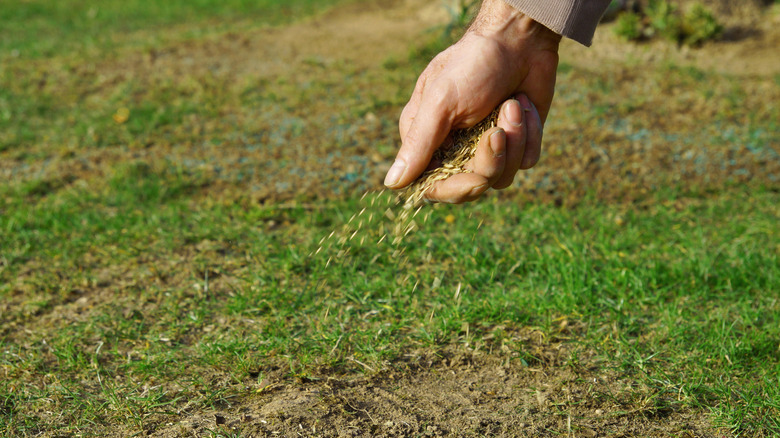The Best Method For Overseeding The Zoysia Grass In Your Yard
There's something about a thick, bright green lawn that makes you want to put in the work to ensure yours is the best one on the block. There's plenty to do to keep your lawn growing and thriving, including providing nutrients and proper moisture, but even then, most lawns benefit from overseeding to increase their overall density. This is true of zoysia grass (Zoysia species), a fast-growing, hardy grass that is common in many American backyards.
While an excellent choice for most warm areas and shade tolerant, it's critical to ensure zoysia grass gets a bit of extra care. You'll find that it takes some time to recover from damage and disease, often requiring overseeding to keep it lush. Some varieties are more drought- and cold-tolerant than others, but poor conditions for any period of time can limit growth. While you don't have to spend a lot of time or money on fertilizing this grass, you will benefit from adding seed properly.
Though it's not easy to overseed zoysia grass, the right method — one that prepares the soil properly and distributes the seeds by hand – can help alleviate some of the challenges. You'll also want to supplement with a bit of fertilizer and provide ongoing support for the new grass seeds to encourage them to sprout. If this is the type of grass seed you plan to sow in your yard, these tips will help you achieve the best outcome.
How to prepare your lawn for overseeding zoysia grass
As an overall low-maintenance grass that creates a thick ground cover, it's worth overseeding zoysia grass if you have bare spots or want to fill it out. Overseeding, which is the process of planting added grass seed directly into the bare spots in your lawn, can be somewhat challenging for this particular type of grass. If you are establishing a new lawn or replacing a larger, damaged area, using grass plugs would likely be more effective. But for overseeding, it's best to plant grass seeds in the later spring months after there is no frost risk and before summer's hot temperatures roll in. Aim for air temperature that's about 80 degrees or higher and soil temperature between 65 and 70 degrees for optimum conditions, though some seed species may prefer cooler temperatures.
Before overseeding, preparing the lawn is recommended. That includes removing all debris on the surface, mowing the existing grass to bring it down to about 1 inch in height, and then aerating. Aeration helps to improve airflow in the soil, which can be critical if you have dense soil that may limit the seeds from sprouting. If there's a buildup of thatch or dead plant material on the upper portion of the lawn, you may also want to consider dethatching the lawn. This helps, again, to allow seeds to germinate and establish.
The overseeding method to use for zoysia grass
Once the soil is prepped, give your grass seed the best boost of nutrition possible. It's often best to add organic material to improve soil quality, but adding a grass-specific fertilizer of any type could help. Also, note that it's best to measure the pH of your soil to ensure the best possible environment. This grass tends to need a higher amount of nitrogen and less potassium than other types. Aim for a pH between 6.0 and 6.5 for ideal conditions.
Once your soil is ready to go, hand-spread your grass seed over the area when possible. This allows you to control the application well, allowing for filling in those bare spots properly. You can also use a push spreader. Your goal should be to cover the surface well. Though varieties can differ, the best coverage is about 2 pounds of grass seed for every 1,000 square feet of space. If you're just covering bare spots, you'll need less. Check the packaging to see how much seed is beneficial based on the variety. Too much isn't ideal since this can lead to overcrowding, too few nutrients to support the grass, and eventual early death. Once the correct amount has been planted, water and keep the soil and seeds moist as they sprout. Don't allow the seeds to sit in water. You should see the grass fill in within a couple of weeks.


